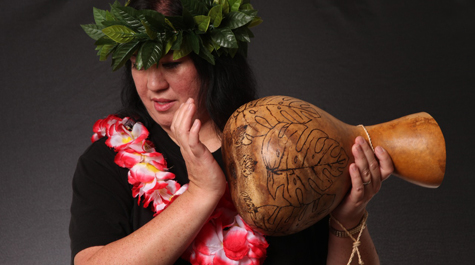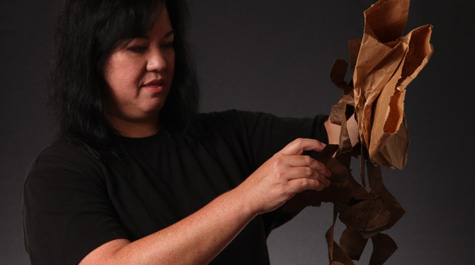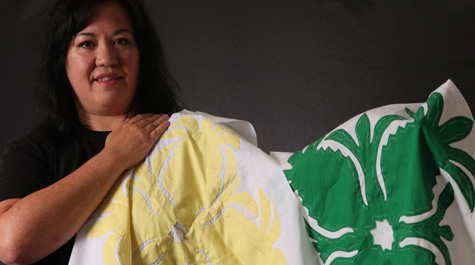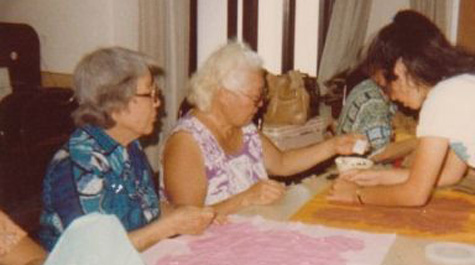Student uses W&M education to preserve, promote Hawaiian culture
Lisa Noelani Robbins ‘14 isn’t just studying finance at the Mason School of Business to better her business. She is doing it to help preserve and perpetuate the Hawaiian culture she holds so dear.
Robbins, a non-traditional student at the College of William & Mary, is a sixth-generation Hawaiian quilter and Hula dance instructor. She does both out of her 'Ohana Arts Studio in Newport News.
{{youtube:medium:left|zApzhQIoRrY, Robbins demonstrates “hula kahiko”}}
The business owner, mother and student grew up between Oahu and the Big Island of Hawaii, called “Moku o Keawe” by native islanders. As a little girl, she learned about the tradition of Hawaiian quilting from her parents, grandmother and great-grandmother.
“(Hawaiian quilting) was actually started when the missionary women came to the islands, but the island women didn’t see the logic of cutting up pieces just to put them together,” said Robbins. “Instead, they did something that’s opposite, which is keep a base of material and then cut out a design, not piece them together.”
As a result, Hawaiian quilting is more like needle-turn applique, said Robbins.
Although she didn’t think much of the tradition while growing up, she finally understood the importance of Hawaiian quilting after her grandmother passed away, she said.
“It’s something that’s important for me to continue and perpetuate it on behalf of the ‘keiki’ (children) who are the future and the ‘kupuna’ (elders/ grandparents) who passed on our traditions to me, so that’s what I do,” said Robbins.
She has now inherited decades-old, brown, paper design patterns from her great-grandmother. Robbins has also inherited complete quilt pieces that were sewn by her grandmother, including two with green and gold pineapple designs -- colors and a symbol with even more importance to Robbins now as a student at the College (whose colors are green and gold) and member of the Williamsburg community (which touts the pineapple as a symbol of hospitality).
 Robbins recently donated some Hawaiian quilting items to the
Colonial Williamsburg Foundation, and she expects to donate two more pieces to
them soon.
Robbins recently donated some Hawaiian quilting items to the
Colonial Williamsburg Foundation, and she expects to donate two more pieces to
them soon.
“I was inspired by Professor Patricia Wesp (in William & Mary’s Department of Theatre, Speech and Dance) because I was enrolled in her historic costuming class last summer with fellow business student, Sherie Wydra, and came across a Hawaiian quilting exhibit for one of our assignments. Sherie and I worked on getting these pieces gifted,” she said.
In addition to her quilting work, Robbins teaches and performs Hula dancing, which she learned from her “kupuna.” There are two main types of Hula, she said, the old style and the contemporary style.
The old style, “hula kahiko,” was danced mainly to give reverence to kings, queens, gods or goddesses, Robbins said.
“Once the ships came into the ports, there came an evolution of the hula to ‘hula 'auana,’ which is contemporary style, which is done for entertainment,” she said. “That’s a different style where you can smile and entertain your guests.”
Instead of giving reverence to sovereigns or deities, the contemporary style aims to tell a story, Robbins said.
Robbins, who left Hawaii in 1986 and spent 12 years in Seattle before moving to Virginia, spent several years teaching Hula classes out of her house and through parks and recreation before she finally established her studio in 2007.
Now, she and her students perform all over the area, often at military functions and once even at the Mason School of Business during their international night.
{{youtube:medium:left|RljGFaUcgi4, Robbins teaches a W&M staff member to hula}}
Robbins said there is actually a large Hawaiian community in the Hampton Roads area due in part to the large military presence in the area. She hopes that her work with quilting and dancing will help to preserve and perpetuate the Hawaiian culture.
“I think it’s important to retain the cultural values and the cultural arts and preserve them as much as we can,” she said.
And what she is learning at William & Mary is helping her in that endeavor. She credits numerous faculty members and administrators with helping her pursue her goals, including Christopher Adkins, Rita Murphy, Jennifer Dahnke, Richard Ash, Nicole Montgomery, Paul Blossom and Christine Westberg.
Robbins noted that the business school’s executive partners – including Joann Kansier, Bob McKnew, Bill Grant, Bob Thompson, Bob Crawford, Paul Whybrow and Rik Spatz – have also been instrumental to her education.
“I am very happy to be at the business school,” she said. “That only enhances me and my business and our culture in order to step it up to the 21st century and beyond,” she said. “It’s given me not just the drive, not just the support, but it’s also good for our culture. It’s given us that in order to perpetuate it.”
Robbins plans on returning to the islands in 2020 to work at a trust for Hawaiian children.
“That’s one of my life goals,” she said. “I’m so grateful to be at the school of business so I’ll be able to do that.”
 Skip to main content
Skip to main content




